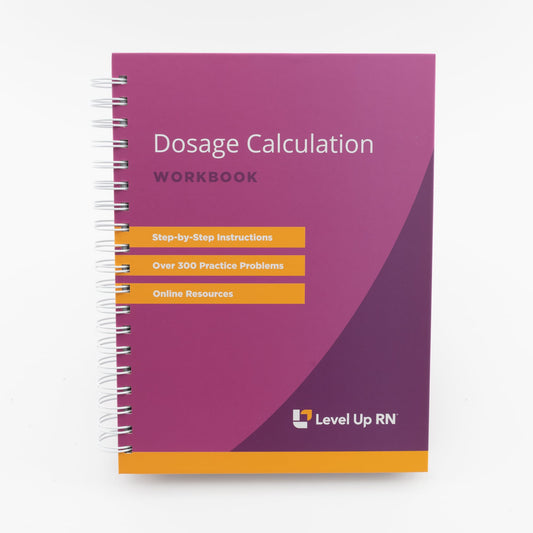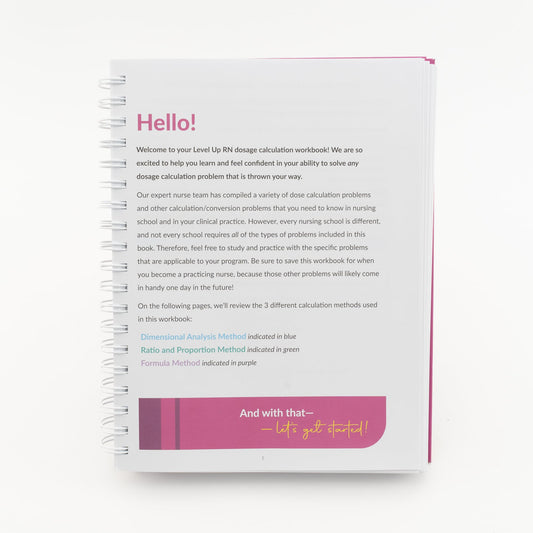Nursing Dosage Calculations, Part 3: Example Problems 6-9
Updated: Cathy ParkesIn this video, Cathy covers Dosage Calculation practice problems 6-9. You can download the practice questions and answer key and follow along as she explains how to work through the problems.
Full Transcript: Nursing Dosage Calculations, Part 3: Example Problems 6-9
Full Transcript: Nursing Dosage Calculations, Part 3: Example Problems 6-9
Cathy Parkes BSN, RN, CWCN, PHN:
I'm going to go over some IV pump calculations now. Problem #6 has an order for 1000ml of some kind of IV fluid to infuse over 6 hours. What is the pump rate in ml/hr? And we want to round to the nearest whole number. Again, if you don't pay attention to that and you don't round, then that's going to be a problem and you're going to get it wrong. This one's pretty easy. 1000ml is going to infuse over 6 hours. If we just do this division, we'll get the rate in ml/hr. Turn on my calculator here... 1000 divided by 6 equals 166.66666, on and on. But again, we're rounding to the nearest whole number. That would be 167ml/hr. That was not too bad, especially after the last one.
We'll pick it up with Problem #7 next. #7 deals with another IV pump calculation. In this scenario, our pump is running at 125ml/hr. The question asks us, “how many hours will it take for 500ml to infuse?” We have 500ml and we are infusing at 125ml/hr. We can cross off our milliliters and we'll end up with hours as our unit of measure, which is what it's asking for here in the question. If I do this calculation, I end up with 4 hours. At this rate, it will take 4 hours for 500ml of fluid to infuse into the patient. That is #7.
We'll pick it up with Problem #8 next. #8 deals with drop factor calculations. In this problem, we have an order to infuse 500ml of normal saline over a 4 hour period of time. In this scenario, we don't have an Alaris IV pump. What we have is a drop factor of 12gtt (that means drops) per milliliter, as far as the tubing set up. We want to know how many drops per minute should be delivered to the patient. Again, this is a scenario where we don't have an IV pump and we have to manually adjust the IV bag and the tubing to deliver a certain drop factor. Let's work through this problem. We want 500ml infused over 4 hours, and we know our drop factor is 12gtt/ml. Our milliliters cross off here and we have drops per hour, but we want drops per minute. We're going to have to say 1 hour equals 60 minutes, to allow us to cross off our hours. Here we can see when we multiply this out, and divide, that we'll end up with drops per minute. If you do that, you end up with 25 drops per minute. Again, we're taking the order and we're just using converting factors to get to the unit of measure that is requested in the problem. In this case, drops per minute. That's #8, hopefully that was helpful.
And we've got one more, Problem #9 next. This is the last problem I'm going to go over in this video. It's #9. This is a problem that deals with calculating how much IV fluids a patient is getting in total, when they're receiving multiple infusions. In this problem, we're told that the patient is getting normal saline infused at 50ml/hr in one of their IVs. Then in another IV, they're getting an IV antibiotic infused every 8 hours. This particular antibiotic is in 100ml of fluid. Then they're getting a second IV antibiotic, every 12 hours. This antibiotic is in 50ml of fluid. The problem asks, "How much IV fluids will the patient get in 24 hours?" We're going to handle each of these separately to figure out how much they're getting of each of these within a 24 hour period of time, and then add those together. For the normal saline, we know that the patient is getting it at 50ml/hr. If we multiply times 24 hours, cross off our hours, that will give us how many milliliters they're going to get over 24 hour period of time. If we do that math, we end up with 1200ml. Next, let's handle the next antibiotic. With that antibiotic, they're going to be getting 100ml of fluid every 8 hours. Over a 24 hour period of time, we're going to be getting 300ml again, the hours cross off here, and we're left with milliliters. Then for the second antibiotic, we're going to be getting 50ml of fluid every 12 hours. Again, if we multiply that times 24 hours, we're going to end with 100ml. When we're calculating how much they get total, as far as fluids, within a 24 hour period, we just add 1200 to 300, which is 1500, plus another 100, is 1600ml total. That is it! We got through all nine practice questions.
I tried to pick a variety of questions that I've seen previously that I think are important for you to know. However, if I have missed a certain type of problem, or there's another type of problem you want me to work through, then definitely leave that in the comments. I'm happy to make another video or two or, or more, as many as are needed so that you guys can really understand how to do these math questions, because I really don't want you to miss any of these math questions on your test.
On your nursing school exams, there will always be these random questions that hardly any nursing student gets right. We need to save our points for those kinds of random, crazy questions. We need to try to get all our math questions right, all our ABG interpretation questions right. That way we save our points for those really difficult questions that are hard for anyone to get right. Hope this video series has been helpful. Again, if you have additional problems or additional questions, you want me to work through, leave them in the comments. Thanks so much for watching!



10 comments
Hello Cathy! Can you do some fluid maintenance problems. Thanks
Thank you for the helpful videos and practice quizzes! Could you please show a few more dosage calculation problems? Thank you
Could you do more weight problems. I am having trouble with safe dosage for children.
Hi Cathy, I love your Level Up RN flashcards! Your flashcards and videos have raised my grades in nursing school while lowering my test-taking anxiety. I now understand and know the material to critically think through the questions and choose the best answer. Have you ever considered making a Level Up RN flashcard deck for dosage calculations or clinical math? Throughout my nursing program, we have to take dosage calculation quizzes before starting the class or clinical. As I progress through the program, the math gets harder, and I tend to forget the important or simple things when working on the problems. Practicing and reviewing with this kind of deck will be very helpful to other nursing students and me, especially when they are put into medical to know how to approach these types of clinical math questions and easy tips to remember the steps. I hope you will consider this request and continue to do what you do because it truly helps!
Hi Cathy! I did not see any reconstitution, especially how to read a drug label and reconstitute.